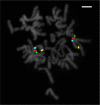4FISH-IF, a four-color dual-gene FISH combined with p63 immunofluorescence to evaluate NKX3.1 and MYC status in prostate cancer
- PMID: 23640976
- PMCID: PMC3707357
- DOI: 10.1369/0022155413490946
4FISH-IF, a four-color dual-gene FISH combined with p63 immunofluorescence to evaluate NKX3.1 and MYC status in prostate cancer
Abstract
NKX3.1 allelic loss and MYC amplification are common events during prostate cancer progression and have been recognized as potential prognostic factors in prostate cancer after radical prostatectomy or precision radiotherapy. We have developed a 4FISH-IF assay (a dual-gene fluorescence in situ hybridization combined with immunofluorescence) to measure both NKX3.1 and MYC status on the same slide. The 4FISH-IF assay contains four probes complementary to chromosome 8 centromere, 8p telomere, 8p21, and 8q24, as well as an antibody targeting the basal cell marker p63 visualized by immunofluorescence. The major advantages of the 4FISH-IF include the distinction between benign and malignant glands directly on the 4FISH-IF slide and the control of truncation artifact. Importantly, this specialized and innovative combined multiprobe and immunofluorescence technique can be performed on diagnostic biopsy specimens, increasing its clinical relevance. Moreover, the assay can be easily performed in a standard clinical molecular pathology laboratory. Globally, the use of 4FISH-IF decreases analytic time, increases confidence in obtained results, and maintains the tissue morphology of the diagnostic specimen.
Keywords: MYC; NKX3.1; biopsy; fluorescence in situ hybridization; immunofluorescence; prostate cancer.
Conflict of interest statement
Figures



Similar articles
-
Decreased NKX3.1 protein expression in focal prostatic atrophy, prostatic intraepithelial neoplasia, and adenocarcinoma: association with gleason score and chromosome 8p deletion.Cancer Res. 2006 Nov 15;66(22):10683-90. doi: 10.1158/0008-5472.CAN-06-0963. Cancer Res. 2006. PMID: 17108105
-
Alterations of C-MYC, NKX3.1, and E-cadherin expression in canine prostate carcinogenesis.Microsc Res Tech. 2013 Dec;76(12):1250-6. doi: 10.1002/jemt.22292. Epub 2013 Sep 12. Microsc Res Tech. 2013. PMID: 24030851
-
MYC overexpression induces prostatic intraepithelial neoplasia and loss of Nkx3.1 in mouse luminal epithelial cells.PLoS One. 2010 Feb 25;5(2):e9427. doi: 10.1371/journal.pone.0009427. PLoS One. 2010. PMID: 20195545 Free PMC article.
-
Regulating NKX3.1 stability and function: Post-translational modifications and structural determinants.Prostate. 2016 May;76(6):523-33. doi: 10.1002/pros.23144. Epub 2016 Feb 4. Prostate. 2016. PMID: 26841725 Review.
-
Mechanisms of prostate tumorigenesis: roles for transcription factors Nkx3.1 and Egr1.Ann N Y Acad Sci. 2005 Nov;1059:33-40. doi: 10.1196/annals.1339.018. Ann N Y Acad Sci. 2005. PMID: 16382041 Review.
Cited by
-
Genomic and Histopathological Tissue Biomarkers That Predict Radiotherapy Response in Localised Prostate Cancer.Biomed Res Int. 2015;2015:238757. doi: 10.1155/2015/238757. Epub 2015 Oct 4. Biomed Res Int. 2015. PMID: 26504789 Free PMC article. Review.
-
Nuclear C-MYC expression level is associated with disease progression and potentially predictive of two year overall survival in prostate cancer.Int J Clin Exp Pathol. 2015 Feb 1;8(2):1878-88. eCollection 2015. Int J Clin Exp Pathol. 2015. PMID: 25973080 Free PMC article.
-
Prognostic prostate tissue biomarkers of potential clinical use.Virchows Arch. 2014 Mar;464(3):293-300. doi: 10.1007/s00428-014-1540-7. Epub 2014 Feb 1. Virchows Arch. 2014. PMID: 24487790 Review.
-
ImmunoFISH is a reliable technique for the assessment of 1p and 19q status in oligodendrogliomas.PLoS One. 2014 Jun 20;9(6):e100342. doi: 10.1371/journal.pone.0100342. eCollection 2014. PLoS One. 2014. PMID: 24949947 Free PMC article.
References
-
- Asatiani E, Huang WX, Wang A, Rodriguez Ortner E, Cavalli LR, Haddad BR, Gelmann EP. 2005. Deletion, methylation, and expression of the NKX3.1 suppressor gene in primary human prostate cancer. Cancer Res. 65:1164–1173 - PubMed
-
- Bethel CR, Faith D, Li X, Guan B, Hicks JL, Lan F, Jenkins RB, Bieberich CJ, De Marzo AM. 2006. Decreased NKX3.1 protein expression in focal prostatic atrophy, prostatic intraepithelial neoplasia, and adenocarcinoma: association with Gleason score and chromosome 8p deletion. Cancer Res. 66:10683–10690 - PubMed
-
- Bowen C, Bubendorf L, Voeller HJ, Slack R, Willi N, Sauter G, Gasser TC, Koivisto P, Lack EE, Kononen J, et al. 2000. Loss of NKX3.1 expression in human prostate cancers correlates with tumor progression. Cancer Res. 60:6111–6115 - PubMed
Publication types
MeSH terms
Substances
LinkOut - more resources
Full Text Sources
Other Literature Sources
Medical
Miscellaneous

